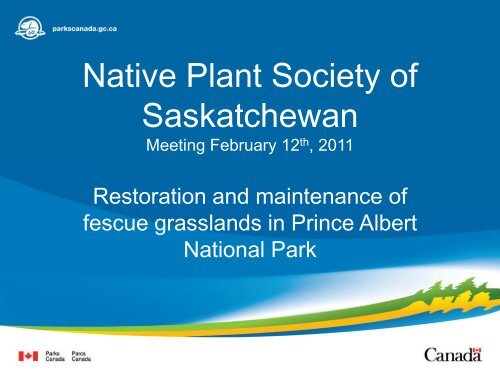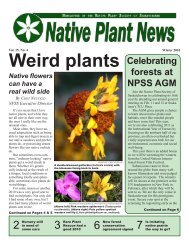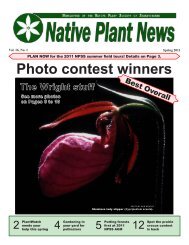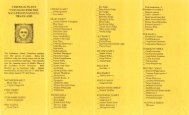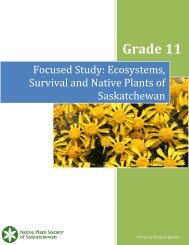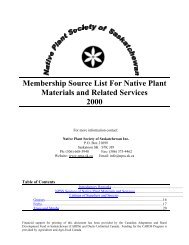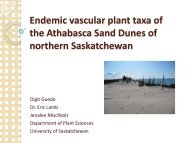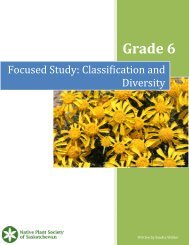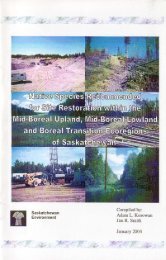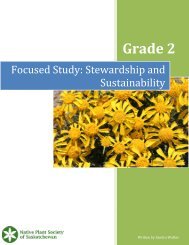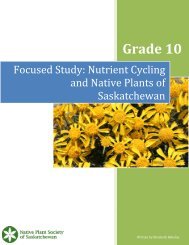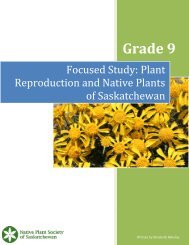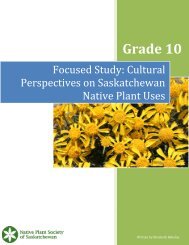Restoration and Maintenance of Fescue Grasslands in Prince Albert ...
Restoration and Maintenance of Fescue Grasslands in Prince Albert ...
Restoration and Maintenance of Fescue Grasslands in Prince Albert ...
You also want an ePaper? Increase the reach of your titles
YUMPU automatically turns print PDFs into web optimized ePapers that Google loves.
Native Plant Society <strong>of</strong>SaskatchewanMeet<strong>in</strong>g February 12 th , 2011<strong>Restoration</strong> <strong>and</strong> ma<strong>in</strong>tenance <strong>of</strong>fescue grassl<strong>and</strong>s <strong>in</strong> Pr<strong>in</strong>ce <strong>Albert</strong>National Park
This presentation will describe:• The regional distribution <strong>of</strong> pla<strong>in</strong>s rough fescuegrassl<strong>and</strong>• The distribution <strong>of</strong> fescue grassl<strong>and</strong>s <strong>in</strong> PANP• Pr<strong>in</strong>ciple threats to fescue grassl<strong>and</strong>s <strong>in</strong> PANP• PANP’s response to these threats
Regional distribution <strong>of</strong> pla<strong>in</strong>srough fescue grassl<strong>and</strong>:• Part <strong>of</strong> the aspen parkl<strong>and</strong> ecoregion• Historic extent 255,000 ha• Marks the transition <strong>of</strong> forest to thenorth <strong>and</strong> open grassl<strong>and</strong> to thesouth• A dynamic mix <strong>of</strong> aspen groves<strong>and</strong> fescue grassl<strong>and</strong>s• Gradual transition - southern areasdom<strong>in</strong>ated by grassl<strong>and</strong>, northernareas dom<strong>in</strong>ated by aspen(Acton et al. 1998)
Regional distribution <strong>of</strong>pla<strong>in</strong>s rough fescuegrassl<strong>and</strong> (Cont.):• Grassl<strong>and</strong> ondrier sites, foreston wetter sites• Floristicallydiversecommunity
Current distribution:• ~ 6% <strong>of</strong> the historicgrassl<strong>and</strong> rema<strong>in</strong>s <strong>in</strong>Saskatchewan• 85 % <strong>of</strong> the rema<strong>in</strong><strong>in</strong>gpatches are < than 65 ha• With<strong>in</strong> Parks Canada,pla<strong>in</strong>s rough fescuegrassl<strong>and</strong> are located <strong>in</strong>– Pr<strong>in</strong>ce <strong>Albert</strong> <strong>and</strong> Rid<strong>in</strong>gMounta<strong>in</strong> National Parks, <strong>and</strong>– Batoche <strong>and</strong> Fort WalshNational Historic Sites(Gerry <strong>and</strong> Anderson 2002)
Threats to therema<strong>in</strong><strong>in</strong>g grassl<strong>and</strong>:• Settlement– l<strong>and</strong> use change• Lack <strong>of</strong> fire disturbance– encroachment <strong>of</strong> aspen• Invasive non-native plants– disturbed sites– edge effect• Overgraz<strong>in</strong>g• Reduction <strong>in</strong> speciesrichness <strong>and</strong> geneticisolation <strong>of</strong> remnant patches
<strong>Fescue</strong> grassl<strong>and</strong>s <strong>in</strong> Pr<strong>in</strong>ce <strong>Albert</strong> NationalPark:• Northern outliers<strong>of</strong> contiguousaspen parkl<strong>and</strong>eco-region• 1968 aerialextent ~670 ha,2010 currentlyunknown(Padbury et al. 1978)• Map shows the location <strong>of</strong> the 18 largest (12-115 ha)grassl<strong>and</strong>s. Many smaller patches are located <strong>in</strong> this area
<strong>Fescue</strong> grassl<strong>and</strong>s <strong>in</strong> PANP:Sugar Creek fescuegrassl<strong>and</strong>s:• Core areas• Seral areas• Forest
<strong>Fescue</strong> grassl<strong>and</strong>s <strong>in</strong> PANP:• Aerial photographsused to determ<strong>in</strong>ehistoric extent <strong>of</strong>grassl<strong>and</strong>s:• 1947• 1962• 1996NAerial Extent <strong>of</strong> <strong>Fescue</strong> Grassl<strong>and</strong>sSugar Creek Meadows1995 - 20.1 hectares1962 - 36.0 hectares1947 - 88.5 hectaresWestside Road0.5 0 0.5 1 Kilometers
Approximately 67% <strong>of</strong>the fescue grassl<strong>and</strong> <strong>in</strong>Pr<strong>in</strong>ce <strong>Albert</strong> NationalPark was overgrow byaspen forest between1947 <strong>and</strong> 1995.Name <strong>of</strong>MeadowJonasson’sFlatsTwelve MileMeadowWasstrom’sFlatsSouth EndMeadowSugar CreekMeadowsAveragedecrease (%)1947area(ha)1962area(ha)Decrease <strong>in</strong>area to 1962(%)1995area(ha)Decrease <strong>in</strong>area to 1995(%)95.0 58.4 39% 40.6 57%9.5 8.7 8% 5.4 43%239.5 132.3 45% 46.2 80%79.9 74.5 7% 16.0 80%88.5 36.0 59% 20.1 77%31.6% 67.4%Currently:Seral grassl<strong>and</strong>support mature(>50 years) forestOnly core grassl<strong>and</strong>srema<strong>in</strong>
Pr<strong>in</strong>ciple threats to fescue grassl<strong>and</strong>s <strong>in</strong>PANP:• An altered fire regime• Encroachment by aspen <strong>and</strong>shrubs• Small <strong>and</strong> highly fragmentedgrassl<strong>and</strong>s• Potential for local ext<strong>in</strong>ction• Reduction <strong>in</strong> genetic diversity• Introduction <strong>and</strong> spread <strong>of</strong><strong>in</strong>vasive non-native plants• Management <strong>of</strong> disturbed sites• Lack <strong>of</strong> public underst<strong>and</strong><strong>in</strong>g<strong>of</strong> the dynamic nature <strong>of</strong>native grassl<strong>and</strong>s
PANP’s response to these threats• Complete a fescue grassl<strong>and</strong> management plan forPr<strong>in</strong>ce <strong>Albert</strong> National Park• Re-<strong>in</strong>troduce a representative fire regime to the areaknown to support fescue grassl<strong>and</strong>s• By 2025, restore select fescue grassl<strong>and</strong>s to between 50<strong>and</strong> 100% <strong>of</strong> their 1947 distribution• Invasive non-native plant species control• Increase public awareness , underst<strong>and</strong><strong>in</strong>g <strong>and</strong>appreciation <strong>of</strong> fescue grassl<strong>and</strong>s
Complete a fescue grassl<strong>and</strong> managementplan for Pr<strong>in</strong>ce <strong>Albert</strong> National ParkA draft plan has beencompleted <strong>and</strong> is about tobe distributed for externalreview.
Re-<strong>in</strong>troduce a representative fire regime tothe area known to support fescue grassl<strong>and</strong>sEstablish an aspenparkl<strong>and</strong> managementunit ( ~ 53,500 ha)
Area burned ( X 1000 ha)R<strong>and</strong>omly <strong>in</strong>troduce a 40year fire cycle to the unit byimplement<strong>in</strong>g prescribedfires (~1,350 ha/yr)20181614121086420Aspen Parkl<strong>and</strong>Expected vs Actual Area BurnedFive Year PeriodPrescribed fires will belarge (100 to 5,000 ha)Older forest will bema<strong>in</strong>ta<strong>in</strong>ed throughoutthe unitExpected Area BurnedActual Area Burned
By 2025, restore specific fescue grassl<strong>and</strong>s tobetween 50 <strong>and</strong> 100% <strong>of</strong> their 1947 distributionSugar Creek, Wasstrom’s Flats,<strong>and</strong> South End grassl<strong>and</strong>s willbe burned 3-5 times <strong>in</strong> a 15year periodName <strong>of</strong>Grassl<strong>and</strong>1947 area(ha)1995area (ha)M<strong>in</strong>imumtarget area <strong>in</strong>2025 (ha)Maximumtarget area<strong>in</strong> 2025 (ha)Wasstrom’sFlats239.5 46.2 120.0 239.5South End 79.9 16.0 40.0 79.9Sugar Creek 88.5 20.1 44.0 88.5Total 407.9 82.3 204 407.9
Sugar Creek Grassl<strong>and</strong> Prescribed Burn~900 ha Burned <strong>in</strong> spr<strong>in</strong>g <strong>of</strong> 2006 <strong>and</strong> 2009.Wasstrom’s FlatsGrassl<strong>and</strong> ~ 1500 ha• Attempted 2010,• Planned for spr<strong>in</strong>g 2011
Invasive non-native plant species controlComplete an <strong>in</strong>ventory<strong>of</strong> the <strong>in</strong>vasive nonnativeplant species <strong>in</strong>the park’s largestfescue grassl<strong>and</strong>sUse the <strong>in</strong>ventory toprioritize controlactions
Re-habilitate large disturbed areas that support<strong>in</strong>vasive non-native plantsGravel pits are located <strong>in</strong> 12Mile <strong>and</strong> South Endgrassl<strong>and</strong>sSmooth brome <strong>and</strong> yellowtoad flax threaten surround<strong>in</strong>ggrassl<strong>and</strong>s12 Mile PitA re-habilitation plan wascompleted for 12 Mile pit <strong>in</strong>2010The plan for the South End pitwill be completed <strong>in</strong> 2012
12 mile gravel pit restoration2010• Basel<strong>in</strong>e monitor<strong>in</strong>g• Initial weed control• Grad<strong>in</strong>g to reduce slopes• Cap site with overburden• Collect native seed
12 mile gravel pit restorationPlans for 2011:• Grow out 8,000 fescue plugs• Early June, control emerg<strong>in</strong>gweeds• Mid June, seed site <strong>and</strong> plantfescue plugs• Irrigate site throughout grow<strong>in</strong>gseason• follow up monitor<strong>in</strong>g
Test the feasibility <strong>of</strong> pilot <strong>in</strong>vasive nonnativeplant control projectsSmooth brome control <strong>in</strong> fescuegrassl<strong>and</strong>sPilot control program <strong>in</strong>itiated <strong>in</strong>2010Canada thistle control <strong>in</strong> wetl<strong>and</strong>meadowsPilot control strategy will becompleted <strong>in</strong> 2011As these species grow alongside native species, control programs must be targeted.
Smooth Brome control <strong>in</strong> the 12 mile meadow:• Weed wicker is used to directlyapply glyphosate to target plants• Maximize height differencebetween target <strong>and</strong> non-targetplants• Multiple applications• Mow yearly prior to seed set,reduce seed bank• Fall mow<strong>in</strong>g to facilitate atargeted spr<strong>in</strong>g application• Monitor to evaluate the program
Increase public awareness <strong>of</strong> the dynamicnature <strong>of</strong> native grassl<strong>and</strong>sProvide opportunitiesfor the public toexperience, learn about,<strong>and</strong> appreciate fescuegrassl<strong>and</strong>– On site <strong>and</strong> <strong>of</strong>fsiteopportunities– Opportunities forvolunteers
For more <strong>in</strong>formation :Please contact:Jeff WeirFire/Vegetation SpecialistPr<strong>in</strong>ce <strong>Albert</strong> National ParkBox 100Waskesiu Lake, Sk.S0J 0N0Phone: (306) 663-4544Email: jeff.weir@pc.gc.ca


